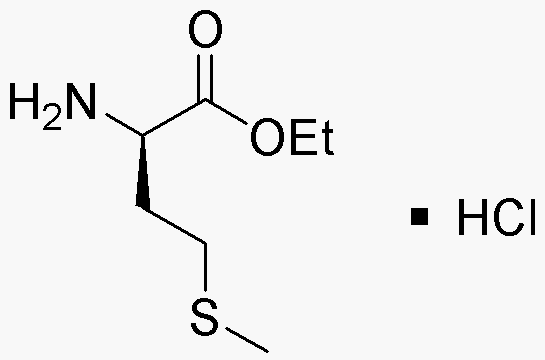D-Methionine ethyl ester hydrochloride is widely utilized in research focused on:
- Nutritional Supplements: This compound is often used in dietary supplements to enhance amino acid profiles, particularly for athletes and individuals seeking muscle recovery and growth.
- Animal Feed Additives: It serves as a feed additive in livestock and poultry industries, promoting better growth rates and overall health in animals.
- Pharmaceutical Development: Researchers leverage its properties in the formulation of drugs targeting liver health and detoxification, providing a natural approach to support metabolic processes.
- Cosmetic Formulations: The compound is incorporated into skincare products for its antioxidant properties, helping to protect skin cells from oxidative stress and promoting a youthful appearance.
- Biochemical Research: It is used in various biochemical assays and studies to investigate metabolic pathways involving sulfur-containing amino acids, contributing to advancements in metabolic research.
General Information
Properties
Safety and Regulations
Applications
D-Methionine ethyl ester hydrochloride is widely utilized in research focused on:
- Nutritional Supplements: This compound is often used in dietary supplements to enhance amino acid profiles, particularly for athletes and individuals seeking muscle recovery and growth.
- Animal Feed Additives: It serves as a feed additive in livestock and poultry industries, promoting better growth rates and overall health in animals.
- Pharmaceutical Development: Researchers leverage its properties in the formulation of drugs targeting liver health and detoxification, providing a natural approach to support metabolic processes.
- Cosmetic Formulations: The compound is incorporated into skincare products for its antioxidant properties, helping to protect skin cells from oxidative stress and promoting a youthful appearance.
- Biochemical Research: It is used in various biochemical assays and studies to investigate metabolic pathways involving sulfur-containing amino acids, contributing to advancements in metabolic research.
Documents
Safety Data Sheets (SDS)
The SDS provides comprehensive safety information on handling, storage, and disposal of the product.
Product Specification (PS)
The PS provides a comprehensive breakdown of the product’s properties, including chemical composition, physical state, purity, and storage requirements. It also details acceptable quality ranges and the product's intended applications.
Certificates of Analysis (COA)
Search for Certificates of Analysis (COA) by entering the products Lot Number. Lot and Batch Numbers can be found on a product’s label following the words ‘Lot’ or ‘Batch’.
*Catalog Number
*Lot Number
Certificates Of Origin (COO)
This COO confirms the country where the product was manufactured, and also details the materials and components used in it and whether it is derived from natural, synthetic, or other specific sources. This certificate may be required for customs, trade, and regulatory compliance.
*Catalog Number
*Lot Number
Safety Data Sheets (SDS)
The SDS provides comprehensive safety information on handling, storage, and disposal of the product.
DownloadProduct Specification (PS)
The PS provides a comprehensive breakdown of the product’s properties, including chemical composition, physical state, purity, and storage requirements. It also details acceptable quality ranges and the product's intended applications.
DownloadCertificates of Analysis (COA)
Search for Certificates of Analysis (COA) by entering the products Lot Number. Lot and Batch Numbers can be found on a product’s label following the words ‘Lot’ or ‘Batch’.
*Catalog Number
*Lot Number
Certificates Of Origin (COO)
This COO confirms the country where the product was manufactured, and also details the materials and components used in it and whether it is derived from natural, synthetic, or other specific sources. This certificate may be required for customs, trade, and regulatory compliance.


